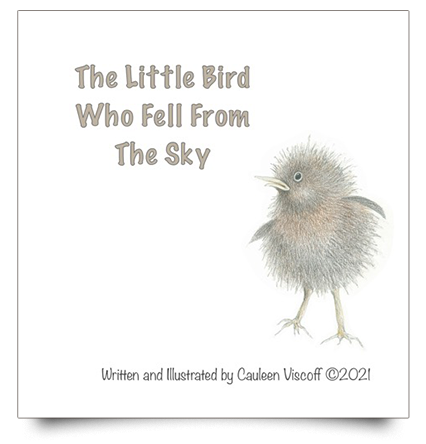I’d love to connect with you! Sign up for my monthly newsletter, "Garden Bliss & Blunder”
Pruning Trees and Shrubs
....why & how to prune
Look to see:
WHEN TO PRUNE
WHAT IS PRUNING
WHY PRUNE
HOW TO PRUNE
GOOD CUTS AND BAD ONES
WHEN TO PRUNE
In Ontario (mostly zone 5 or 6) prune in early March; although there may still be lots of snow, it is time to start pruning:
Oh, and TOOLS... here's what I use and why....
Experts say: “late dormant season”…. which in our zone 5, means late winter, before the spring growth begins.
Early March can be “late winter or early spring” but even with 3 feet of snow, the snowbanks could still be 6 feet tall.
So, pour another cup of tea and wait a bit...
It is easier to see the shape of a tree or shrub when there are no leaves and easier to see what to prune.
Prune before new growth happens: first, because pruning encourages new growth and also any pruning mistakes (open bark -wounds) will seal over more quickly.
WHAT EXACTLY, IS PRUNING...
The University of Minnesota says this:
“Pruning is a horticultural practice that alters the form and growth of a plant. Based on aesthetics and science, pruning can also be considered preventive maintenance. Many problems may be prevented by pruning correctly during formative years for a tree or shrub”.
As for me, I grew up with a dictionary,
so I looked up “pruning” and found these words.
- “barbering” - we aren’t using scissors here
- “curtailing”- sounds too much like curfew
- “chopping” - not unless the plant is dead
- “excising” - sounds too much like
- “surgery“ - lobbing off - as in your head?
- “whittling - needs more muscle than a penknife
- “clipping” - well, perhaps a little…
However, ask any pruning expert and these are the words they use:
- “Eliminating superfluous matter”
- What exactly is superfluous ?
- “ Horticultural practice involving selective removal of certain parts of a plant”
- Which parts ?
- “Targeted removal” - damaged, diseased, dead or non-productive, or structurally unsound or otherwise unwanted tissue from plants”
- I can live with this one…
WHY DO WE PRUNE?
- to keep trees and shrubs healthy
- to maintain a pleasing shape - (don’t plant a tree with one natural form then try to prune it to take on the shape of another.
- Choose one for its natural shape and prune it to stay that way.
- to encourage flowers, fruit and/or seeds.
- to train young trees to be structurally strong
- to REJUVENATE a tree and keep it young
- reduce the incidence of disease
"The best friend on earth of man is the tree:
when we use the tree respectfully
and economically
we have one of the greatest resources of the earth".
Frank Lloyd Wright
TREES DON'T HEAL - THEY SEAL
trees do not heal, they seal.
... and they do a good job by themselves.
In the past, arborists used a tar-based sealant to cover a cut branch wound. But research shows this can actually delay the tree’s natural ability to seal the wound.
There are some exceptions: See Oaks… below
When we prune living tissue, we put the tree into some shock, depending on how hard we prune.
Pruning shoots and branches with live foliage will slow and often stop ROOT growth because the tree is now attempting to replace those branches we just removed with new growth.
Which is why it's best to prune when they are dormant.
DELAY PRUNING FOR THESE:
- for certain trees:
Oak -
Do NOT prune between April and October to avoid Oak Wilt.
If you have to do some pruning during these months, you must apply a wound dressing that masks the odour of freshly cut wood - because the beetles who spread Oak Wilt, love that smell.
Honey Locust
Best is late winter -
...if they must be pruned in summer, do not choose a rainy or humid day as this can increase the risk of ‘stem cankers”
TREE CANKERS
What are Cankers?
“Disease symptoms include dieback of affected branches, reduced foliage, yellow foliage, premature fall coloration and early leaf drop. Cankers (areas of dead tissue) are found at the base of trees, at branch crotches, around wounds or on branch stubs.
Cankers can range from slightly flattened surfaces to distinctly sunken areas with large callus ridges at the canker margin. Areas of stems and branches with thin bark may have a red-yellow discoloration.
The condition of the bark and cambium (the tree’s growth tissue, between bark and wood) can indicate the presence of a canker.
Infected bark and cambium will be loose and wood beneath them may have a dark, wine-red to yellow discoloration instead of a normal white or light color. The reddish color associated with the center of honeylocust stems is not related to these diseases”.
Extension: Colorado State Univ.
Honey locust diseases - W.R. Jacobi
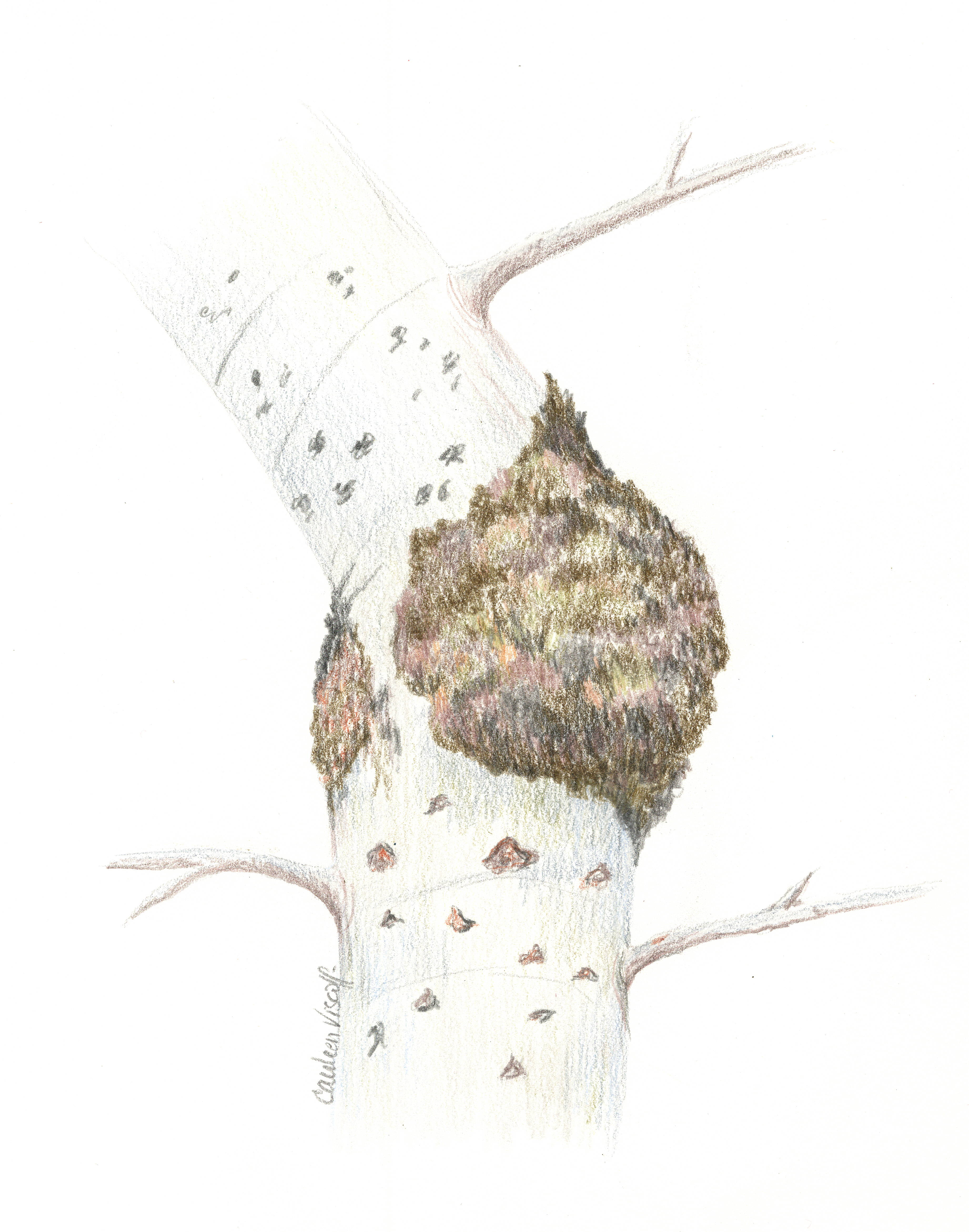
Canker on Poplar Tree
WHEN TO PRUNE THESE...
Apple
Flowering Crab
Mountain Ash
Hawthorn
Shrub Cotoneaster
Even though pruning in late winter is most often recommended, for apple trees, you may be pruning off the fruiting wood. So take only the dead, dying or diseased wood and save the hard pruning for the summer after they bloom (without cutting the new little apple growths).
There are many good videos by fruit farmers that show you how.
FIREBLIGHT
Sometimes, pruning in the spring or summer can increase the chance of disease such as the bacterial “fireblight”.
What is FIREBLIGHT?
Excerpt from Publication 310,
Integrated Pest Management for Apples.
Fireblight is a serious disease causing considerable damage and economic losses in apple and pear. The disease is caused by a bacterium, Erwinia amylovora (Burrill), which infects hosts in the Rosaeceae family.
The host plants include quince, crab apple, hawthorn, cotoneaster, mountain ash and firethorn. The bacteria E. amylovora is found in most areas of the province where apples are grown.
It can be spread by pollinators from the oozing pathogen sap to the flowers.
The pathogen has caused most damage in southwestern Ontario, where, in some years, whole orchard blocks have been destroyed due to severe infections.
Fire blight has become a serious problem in high density apple plantings that contain new susceptible varieties and dwarfing rootstocks
IT LOOKS LIKE...
Reddish brown stained sapwood Bark on branch or trunk cankers appear sunken, dark and may be cracked or peeling. If bark is peeled back, brown staining of the sapwood can be seen.
Droplets of cream to light-yellow coloured ooze is found along infected branches, shoots or fruit during humid weather or after a rain.
Prune out fire blight infected limbs and branches by cutting about 30 cm or more beyond the visible symptom into two-year-old or older wood.
See also: www.omafra.gov.on.ca (for more on Fireblight)
It can start like this....
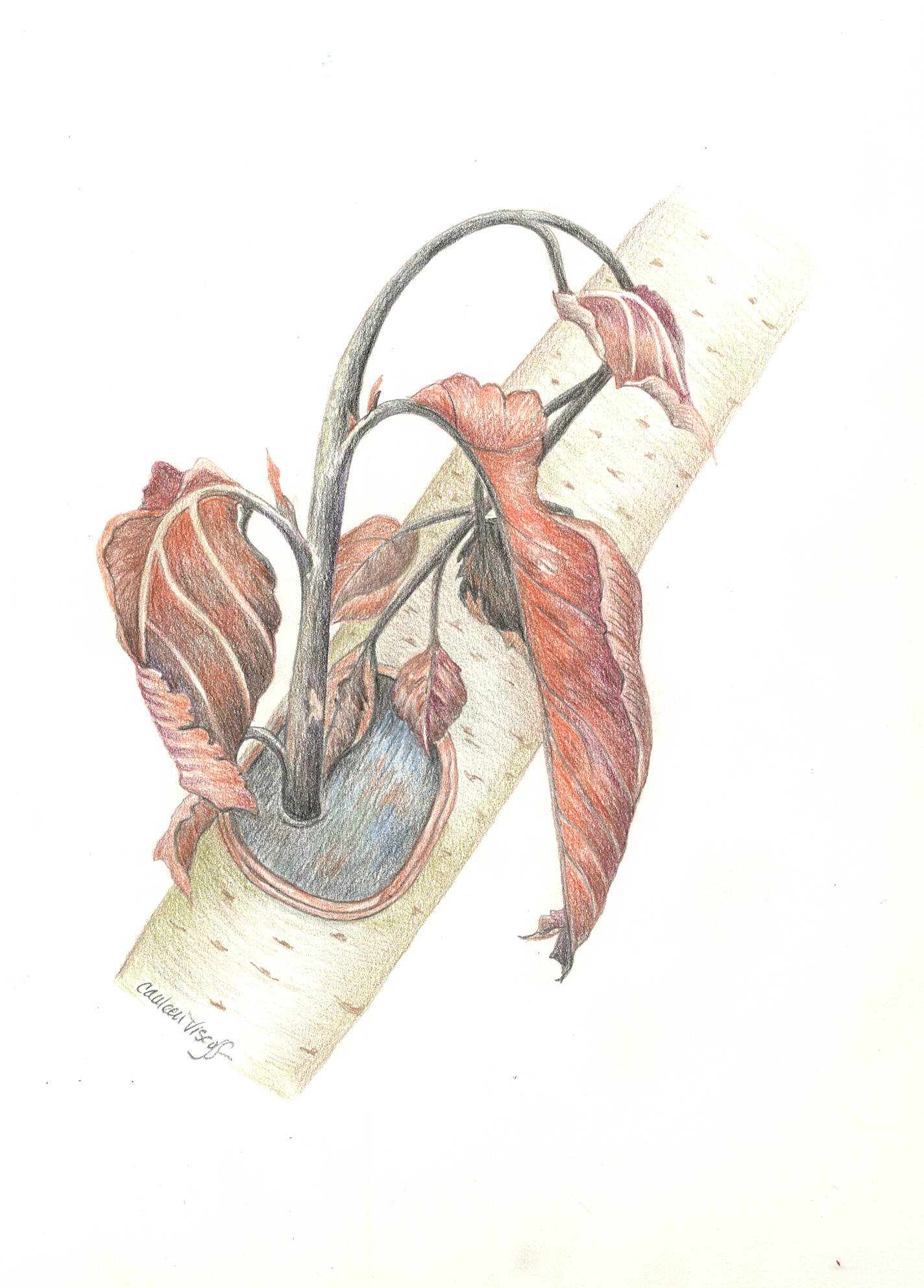
or this...
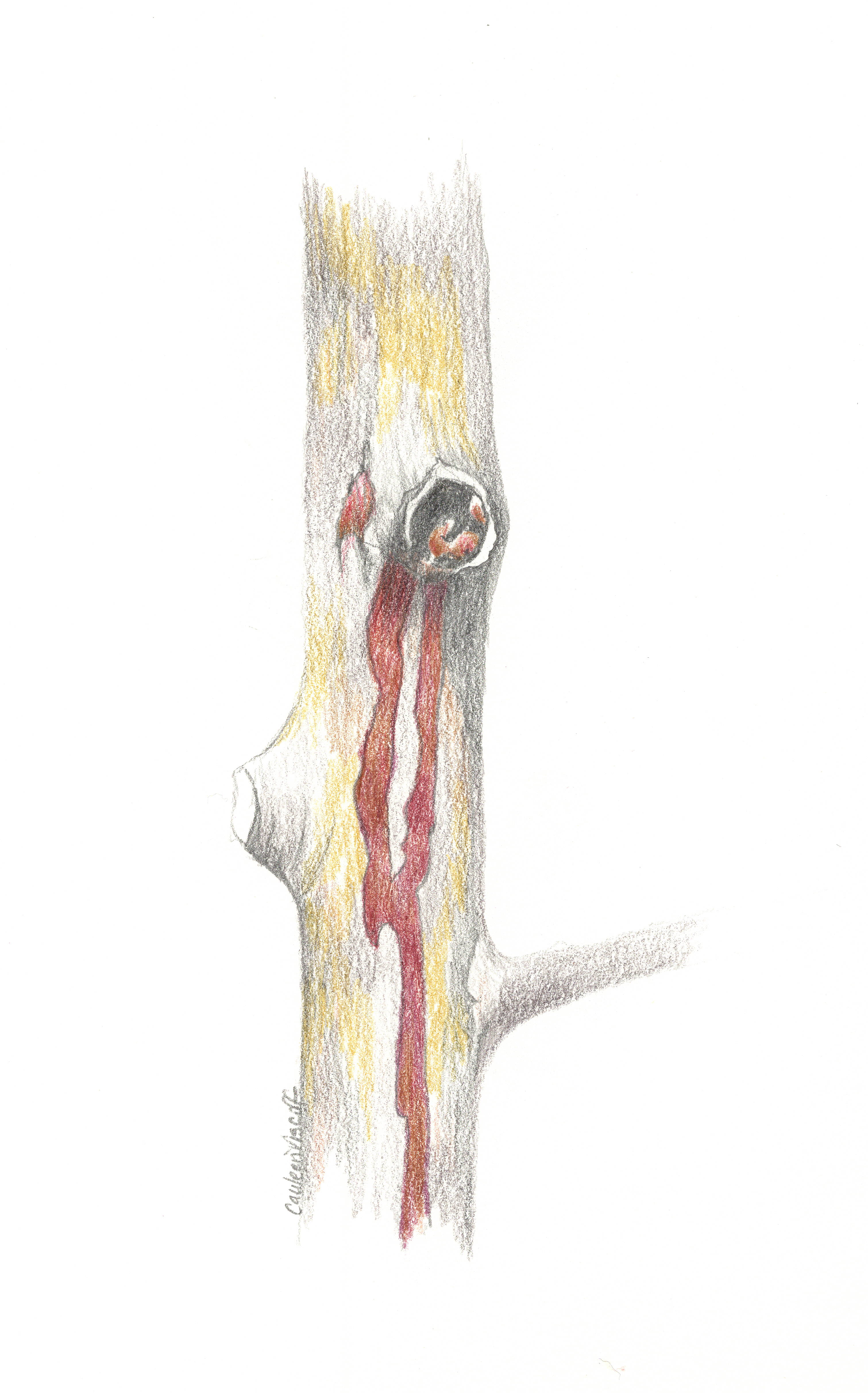 Early signs of pathogen oozing.
Early signs of pathogen oozing.If you plant APPLE or PEAR trees,
watch for this to catch it early.
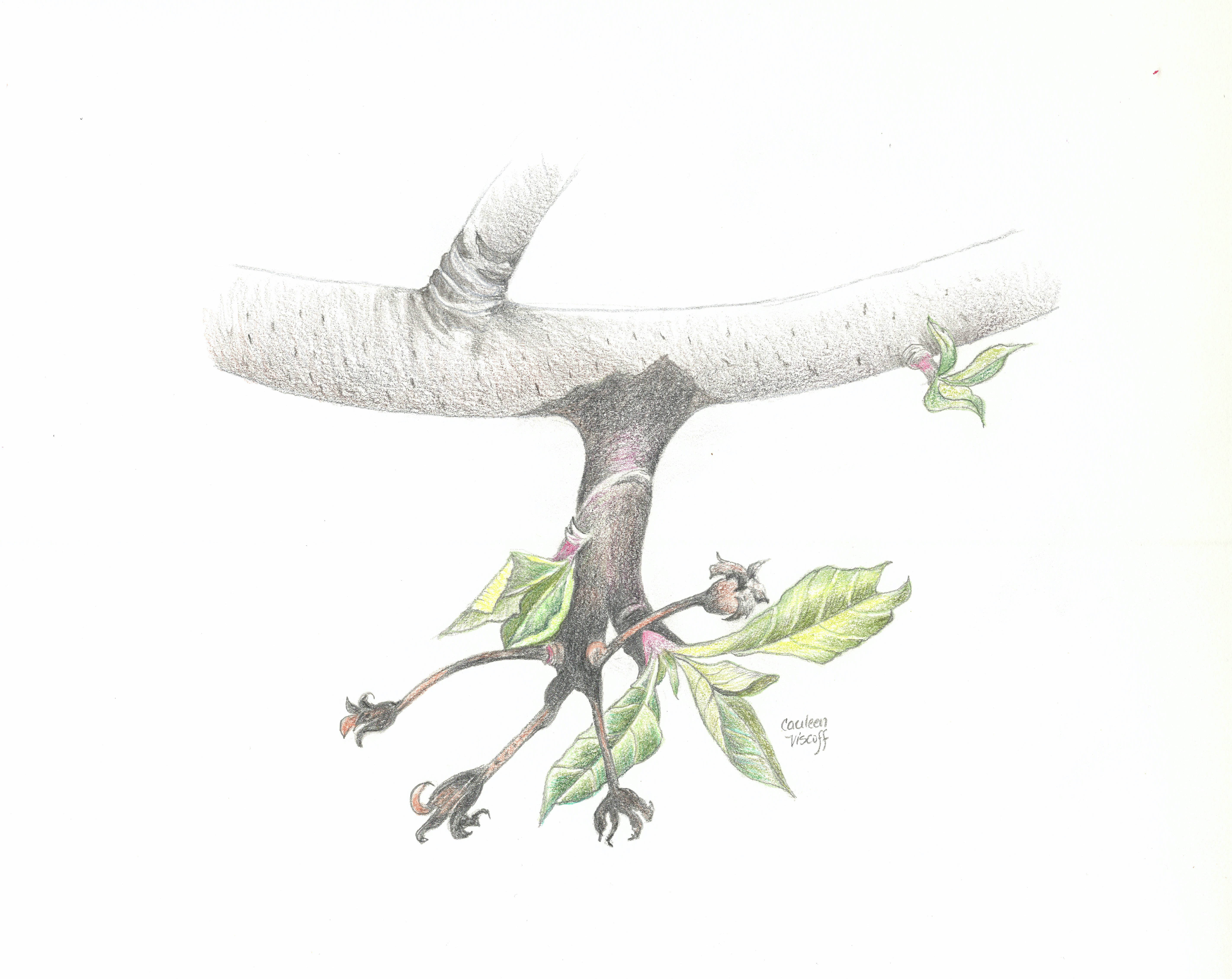 Old bloom
Old bloomIt can also show up on old dead blooms like these above.
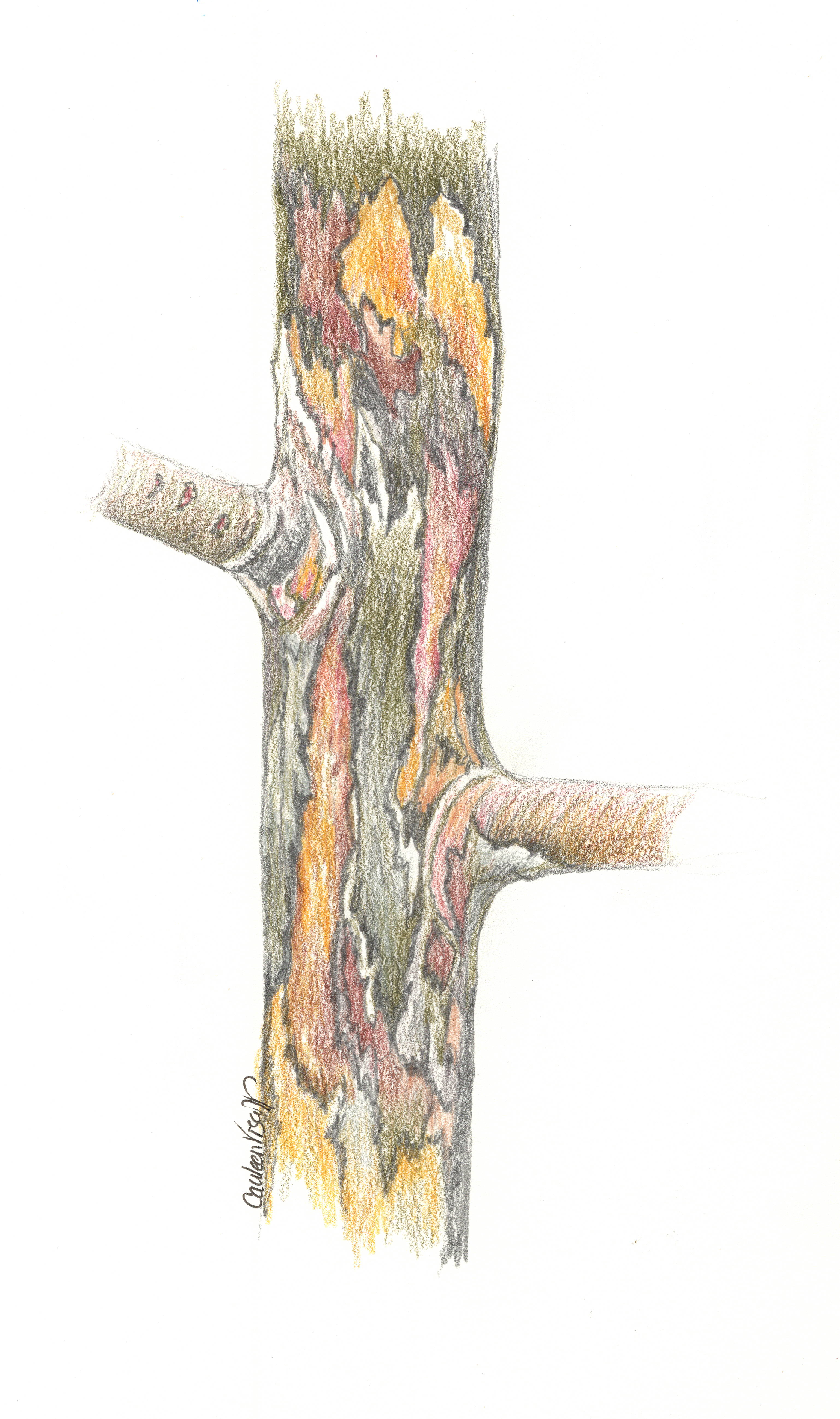 Advanced Fireblight
Advanced FireblightFireblight this far advanced will necessitate the tree being cut to the ground.
PRUNING SAP TREES...
When to Prune Sap trees:
All Maples
Elder
Butternut
Walnut
Birch
Ironwood
Beech
These trees, like sugar maples have sap that starts flowing in early spring. If pruned when the sap is flowing the tree appears to bleed. This doesn't do a lot of harm, but it is better to prune once the leaves are fully out.
Remember not to take off more than 1/4 of the live foliage as it is too stressful for the tree to replace those branches and work on its roots too.
PRUNING FLOWERING TREES
When to Prune Flowering Trees:
Azalea
Chokecherry
Forsythia (when it blooms, prune your roses)
Currant
Flowering Plum or Cherry
Lilac
Magnolia
Early blooming Spirea.
These early bloomers (spring and early summer) will send out flowers on LAST YEAR’S wood,
Prune these AFTER they finish blooming, otherwise you will prune off the buds that are meant for the next spring flowering.
If you HAVE to prune an early flowering shrub, leave as many branches with flower buds and prune only if the branches impede walking or parking. Save the rest for post-flowering.
If you prune summer-flowering shrubs late in the summer or early fall, you are likely to stimulate new growth that might be too tender to survive winter.
WHEN TO PRUNE SHRUBS...
When to Prune Shrubs
Barberry
Burning Bush
Dogwood
Honeysuckle
Ninebark
Peashrub
Purple-leaf Sandcherry
Smokebush
Sumac.
These shrubs are often planted for their foliage, and not necessarily for their blossoms, so prune them in early spring before any growth begins.
Clematis and shrub roses should be cut back to live wood.
Roses do need special consideration so see more here..
PRUNING ROSES
PRUNING HYDRANGEA
ANNABELLE HYDRANGEA
Shrubs that bloom on new wood, should be pruned before any growth begins such as Annabelle Hydrangeas: cut these back to the first or second pair of buds above the ground. The stems will be stronger to support their large heads.
TIP:
I like to cut Annabelles - (Hydrangea arborescens) back in a staggered manner - especially if they grow next to a wall…this way the blooms cover the bush in layers rather than all at the top.
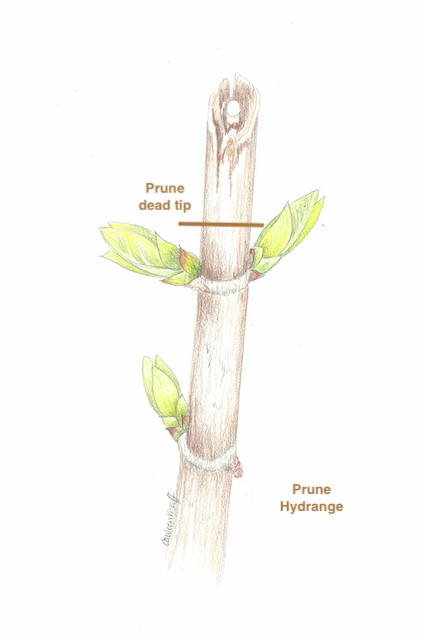
PRUNING HYDRANGEA TREES
For Hydrangea trees;
First look at the amount of growth from last season.
Your new blooms will be on new growth
…If left unpruned, the new growth will begin where the old growth stops and continue out from there…making your bush or tree huge with heavy blooms that can bend and break the stems..
Cut back the old blooms to just above a tiny bud on the sides of the branch. And then,
- cut dried blooms
- dead stems or branches
- crossing and rubbing
- small, weak stems that can’t support heavy blooms
- very long branches
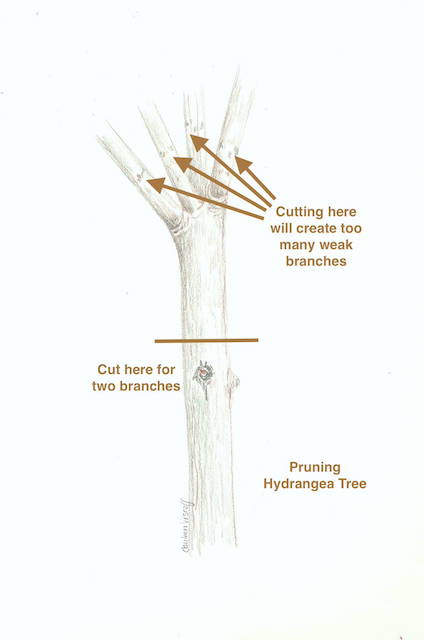
PRUNING SPIREA
SPIREA
- the old-fashioned kind that grows out of control and often seen in hedges, spilling over sidewalks and gardens. They can be cut almost to the ground every few years to bring back healthier bushes. It may not bloom the first year of hard pruning, but most likely will the second year.
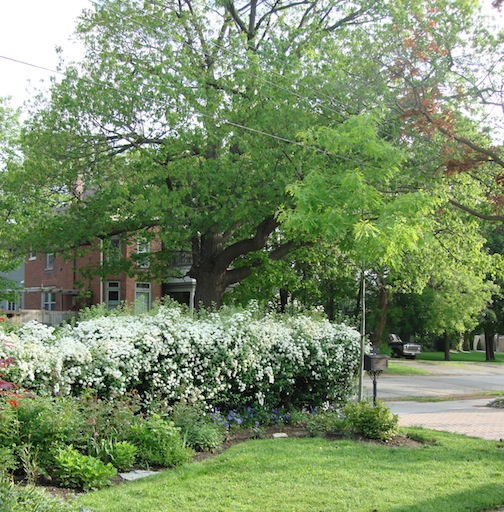
This Spirea Hedge above, full of white flowers,
spilled over the garden and the city sidewalk.
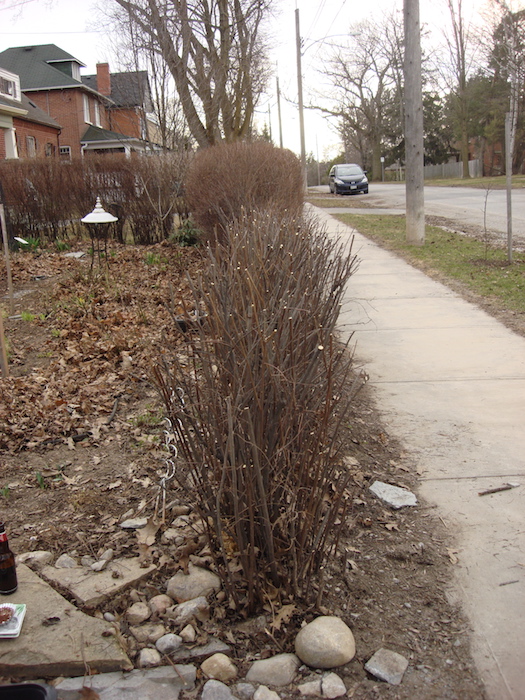 |
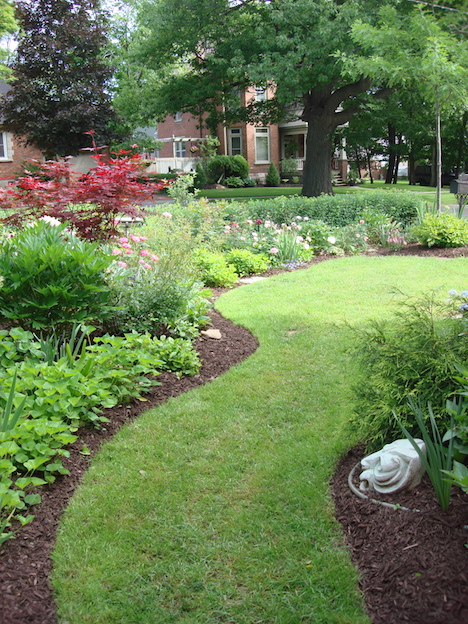 |
LEFT ABOVE, I cut back the hedge in very early Spring - with my secateurs (hand clippers). It was time consuming and I took a lot of kidding from my neighbour who hacked off the top of his - with electric shears.
I cut out all dead stems to the ground, (they are greyer, brittle and will often pull out of the ground with little effort). I then cut the other stems in a staggered manner so the foliage would grow up along the canes, or branches, all the way to the top.
RIGHT, ABOVE, this is the hedge the end of June (seen just above the garden to the right of the Japanese Maple). Very few flowers (until next year) but lush and healthy.
My neighbour's hedge? all the new growth was at the top and bare stems at the bottom.
HOW TO PRUNE
TYPES OF CUTS:
Heading cuts:
For Shape:
Cut a branch back to a bud that faces - or heads - in the direction you wish it to grow.
For these cuts, prune just 1/4 of an inch above the bud and slope your cut down at about a 45 degree angle.
Thinning cuts:
Are for Health:
Take out any dead, diseased, damaged branches or those that cross or rub against another
Thinning cuts keep the natural shape or reduce height.
Some interior branches can be cut to the ground bringing in more light and air to the centre, creating a fuller, more dense growth.
- illustration below: from www.njaes.rutgers.edu
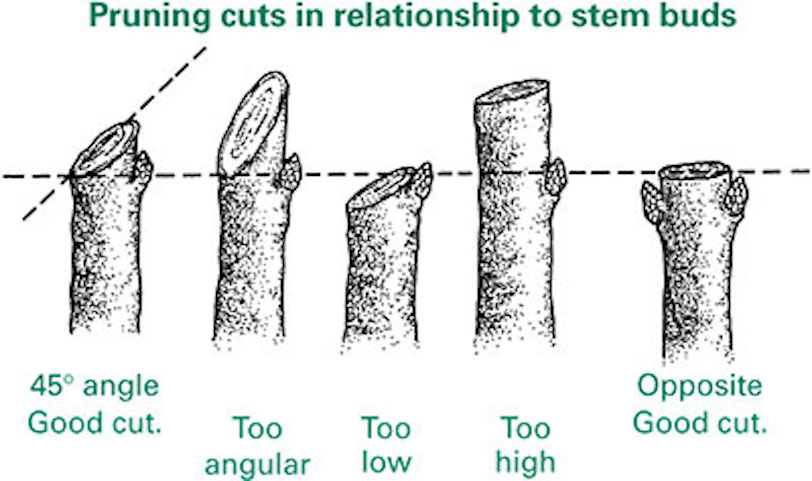
Start with the 4 D’s….
Remove any dead, diseased, damaged or double-crossing branches, including old branch stubs.
 Dead, Diseased or Dying
Dead, Diseased or Dying... cut back to healthy branch.
Depending on its size, this tree would most likely need an arborist to prune this successfully.
Next, remove all suckers or water-sprouts (the ones that grow straight up- making the tree look like it has a bad haircut) - (they syphon off the nutrients that the tree and roots need).
Take branches that cross or rub on others and any that grow toward the centre of the tree.
Although you will need some growth in the middle, too much will keep air and light from the tree - trees need air, light and water in order to pass the nutrients to the roots.
Never cut or prune a single leader- if there are two, and the tree is young, remove the one that is least likely to contribute to the overall shape and health of the tree but only if the cutting will not kill the tree.
Then, before you do one more cut - step back to see where you should go next….
Remove branches that are too close together, crossing or rubbing.
Leave those with the most potential to add to the shape, strength and structure of the tree..
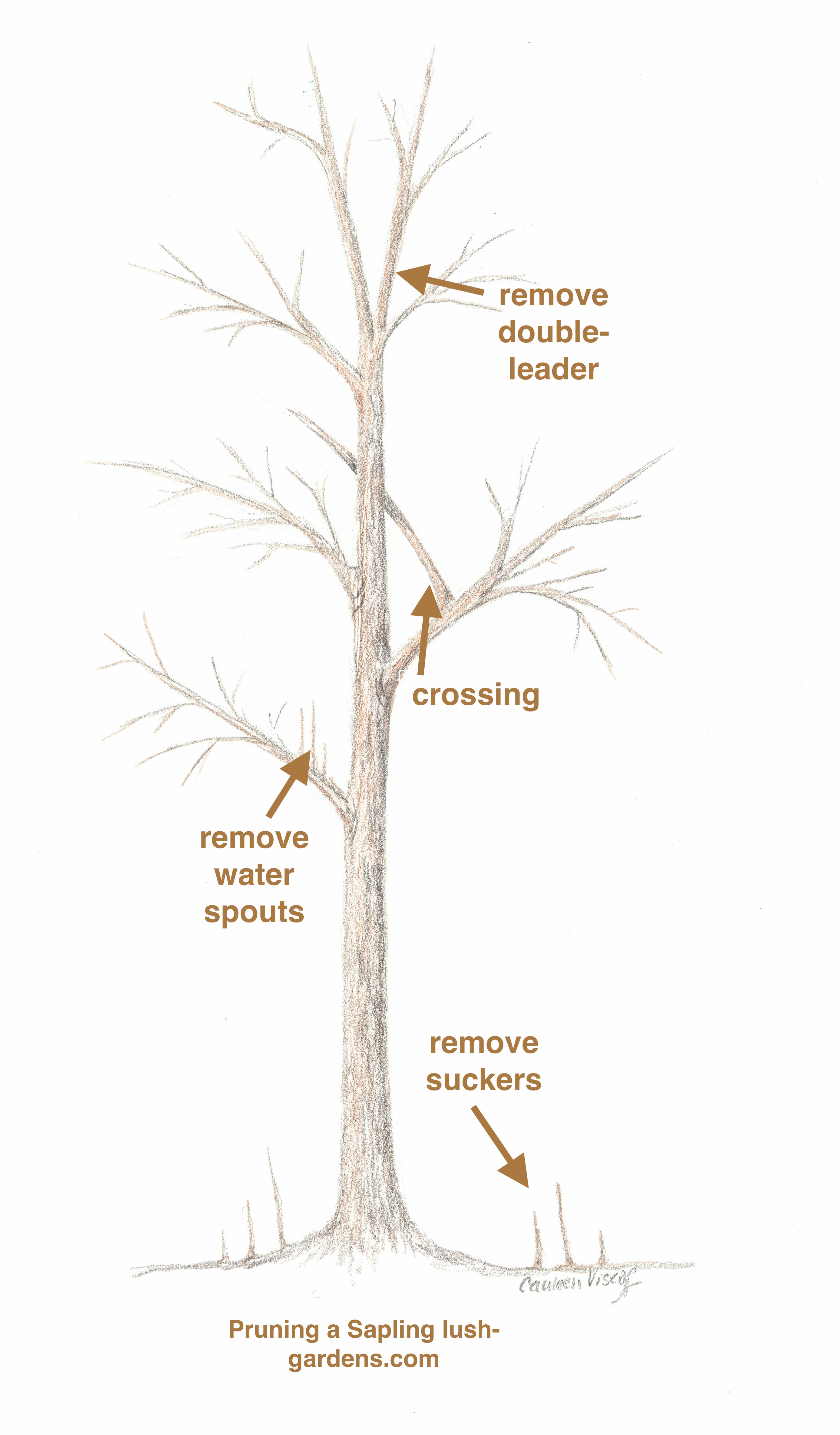
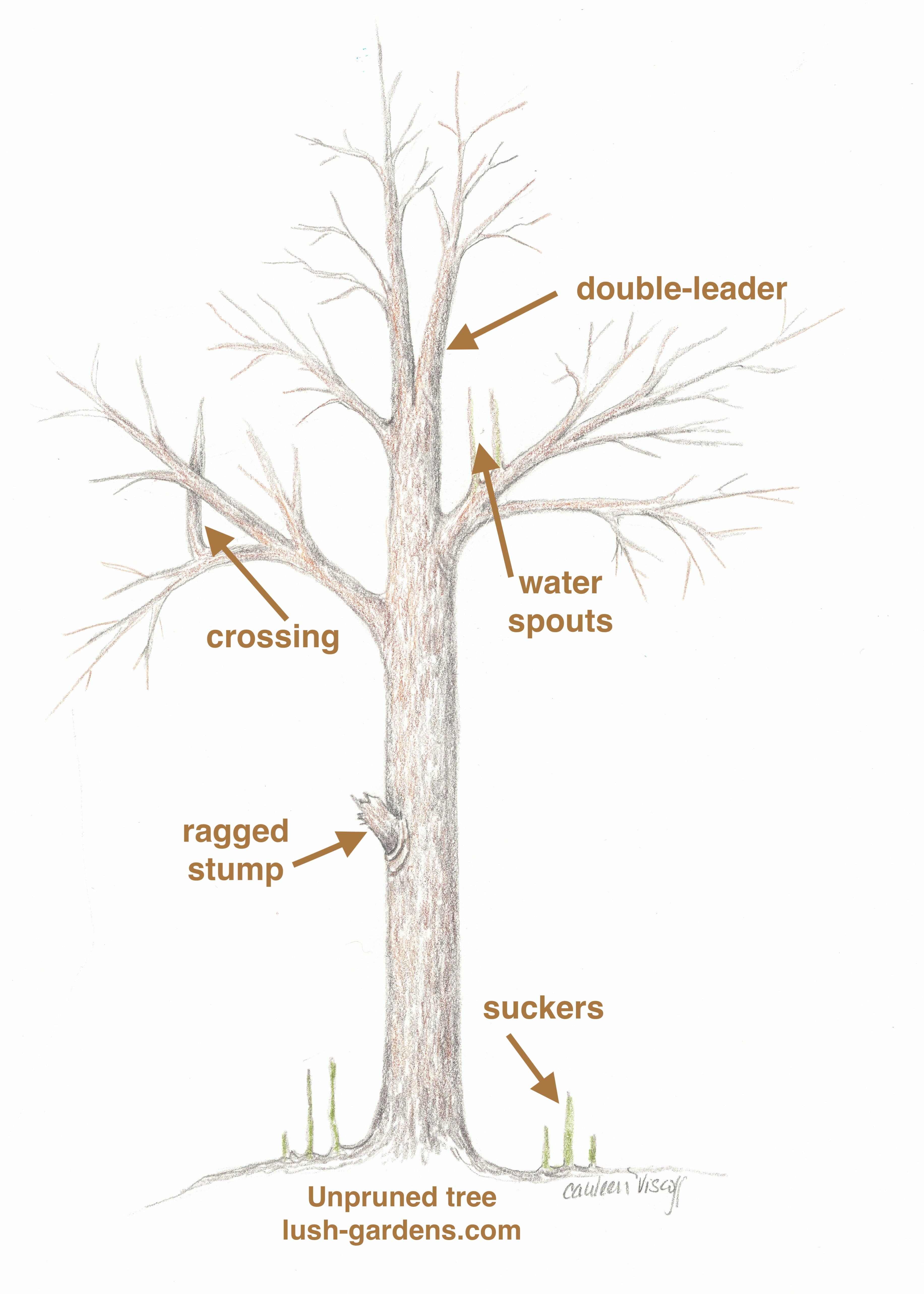
SOME OTHER DO’S AND DON’TS
Do not put any type of paint on a pruning cut.It will not prevent the cut from rotting or decaying, nor does it promote healing…
Tree cuts do not heal, they seal…
If the cut is made properly, the tree will take care of the rest.
Do not “top” trees
- when you remove those large branches from the top of the tree, you not only harm the tree’s natural shape, you decrease the living leaves needed for photosynthesis to gather nutrients that feed the tree’s roots.
Take off only one-third for flowering shrubs:,
- NOT more than one-third of the oldest wood canes or branches at ground level
- NOT more than one-third of the newer canes or branches
- NOT more than one-third off the top…
This way the plant can keep renewing itself with as little stress as possible.
DECIDUOUS HEDGES
Electric shears work well and quickly, but they bruise and tear leaves. Even if you trim the top of your hedge regularly, it will not produce more growth from the bottom and the flowers will be only at the top.
Trimming off the top, cuts off the flowering buds and encourages thick , tangled growth which will shade the bottom and the inside of the hedge.
The inside will become woody and dead with fewer and fewer flowers. (Spirea, especially).
Privet and Spirea will come back vigorously when pruned almost to the ground every 4 or 5 years, and, it will bloom again.
A few last words of advice:
PRUNING is an ART
Anyone can "trim" a bush, but to prune for health and shape is a special skill.
You can learn to do it yourself, but if you don't have time, then hire someone who prunes by hand.
ELECTRIC TRIMMERS are for TRIMMING.
Hand pruners are used for pruning.
If you intend to hire someone, be sure to ask how they do it exactly and make sure they do as you ask.
Some bad cuts
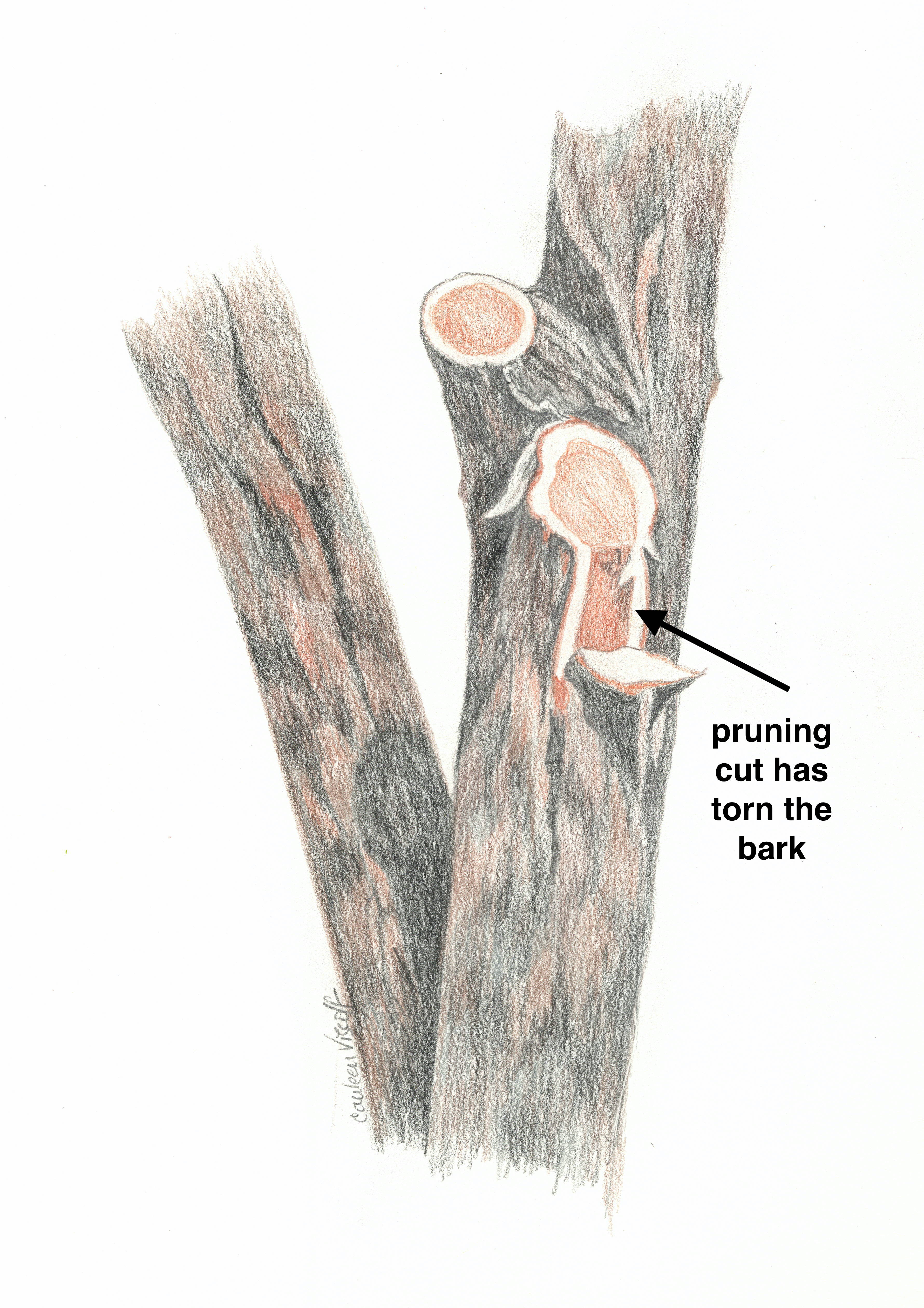
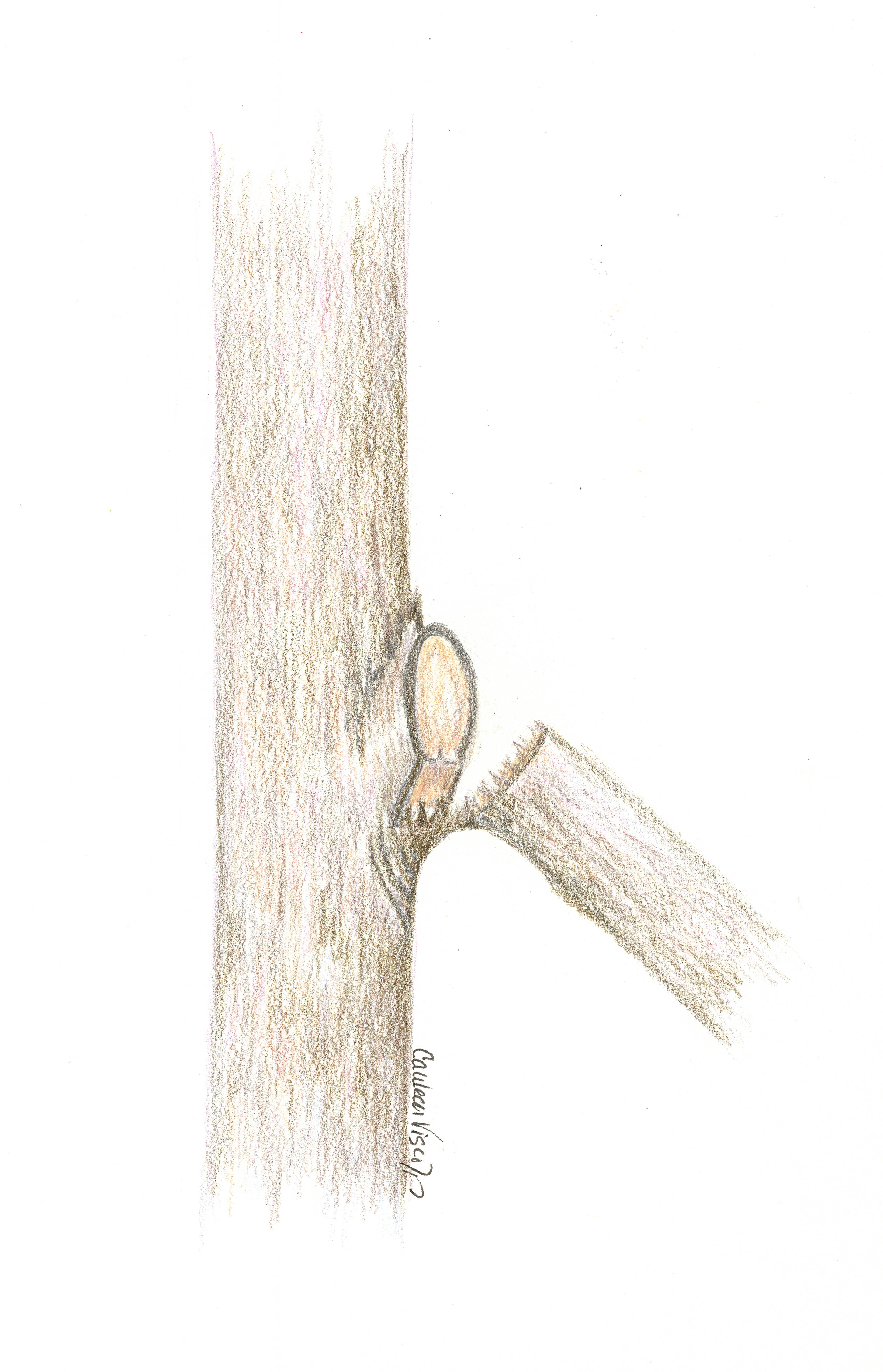
Bark-ripping cut.... dull cutter or carelessness
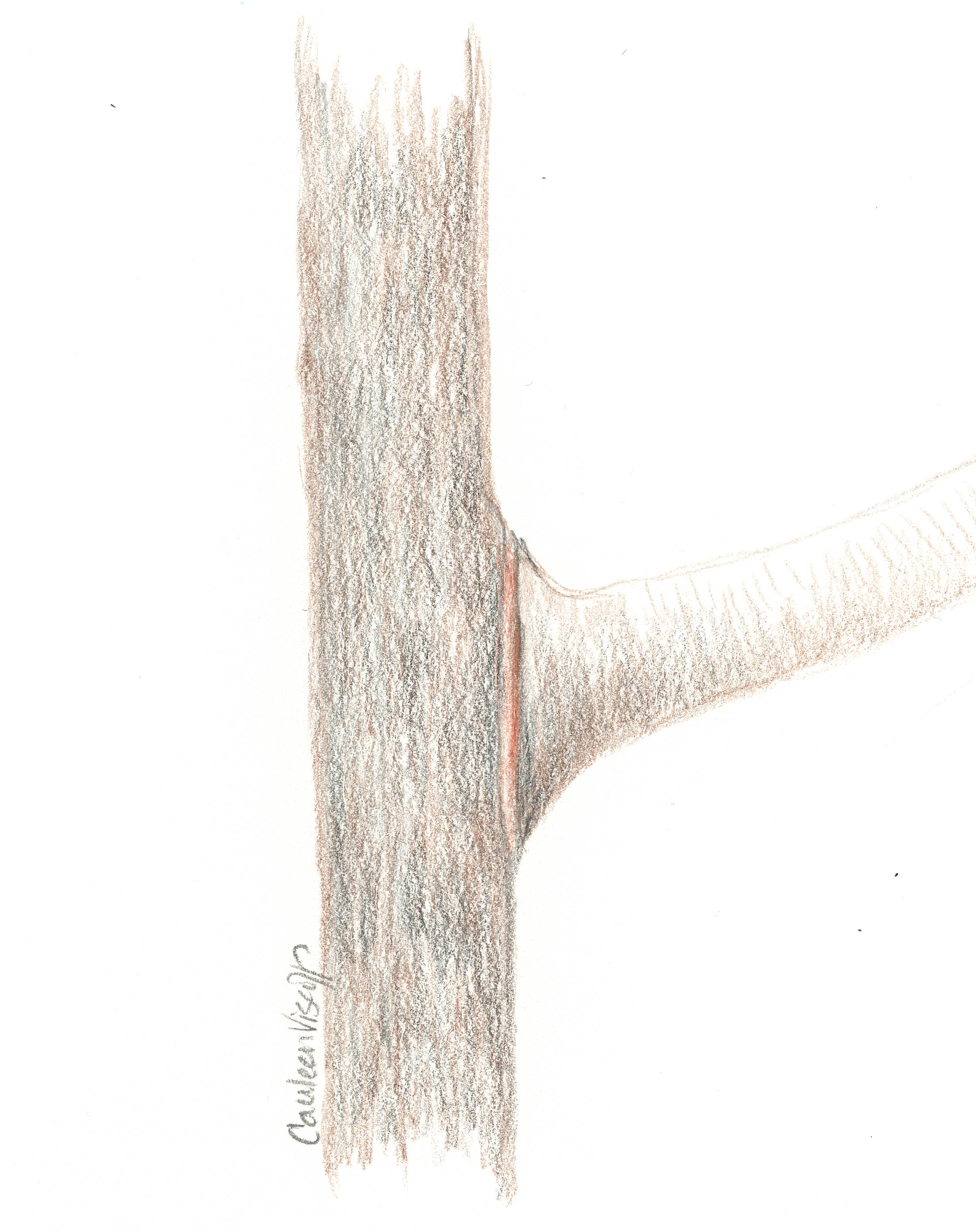
This cut is flush to the trunk - damaging the tree's own healing system which makes it not heal well, introducing possible decay and ultimate death.
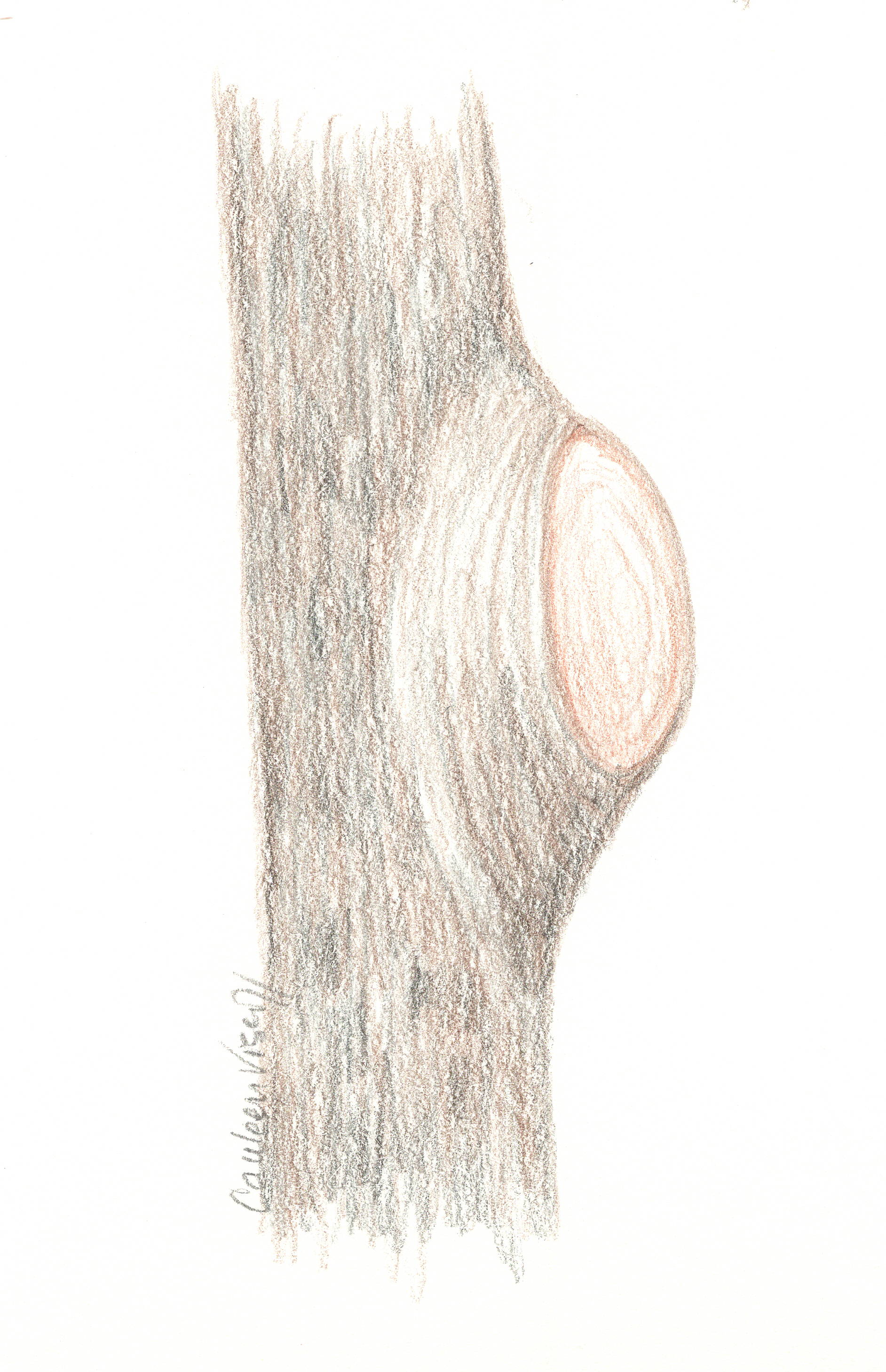
This is a GOOD clean cut above the branch collar (those rings that emerge from the trunk)... the cut will shrink and the tree will produce more bark to cover the cut area.
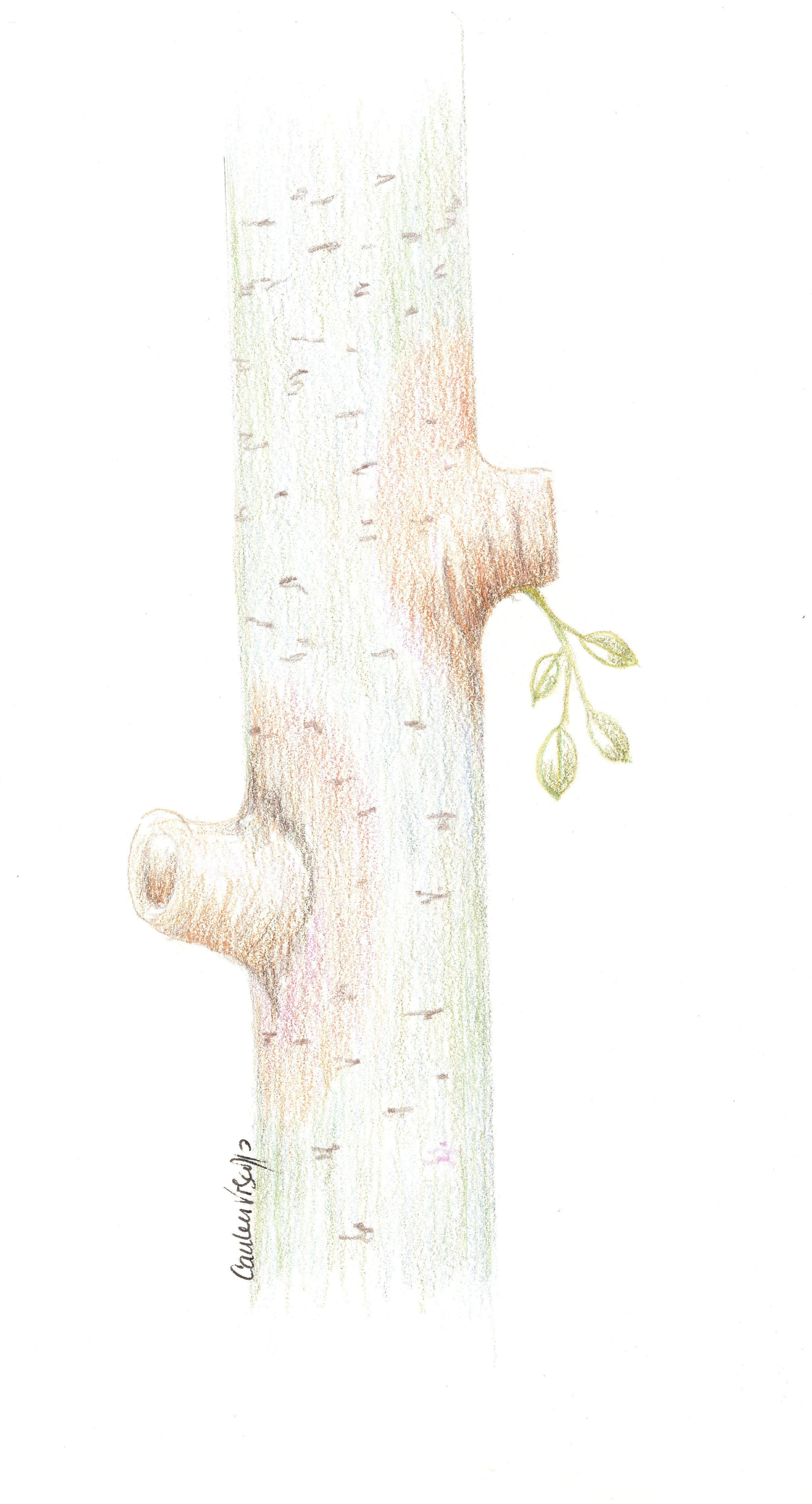
These are "STUB CUTS" ... too far from the trunk making the tree send more energy to the cut area which often results in dying tissue surrounding the stub.. (shown by the discoloured brown-ish areas).
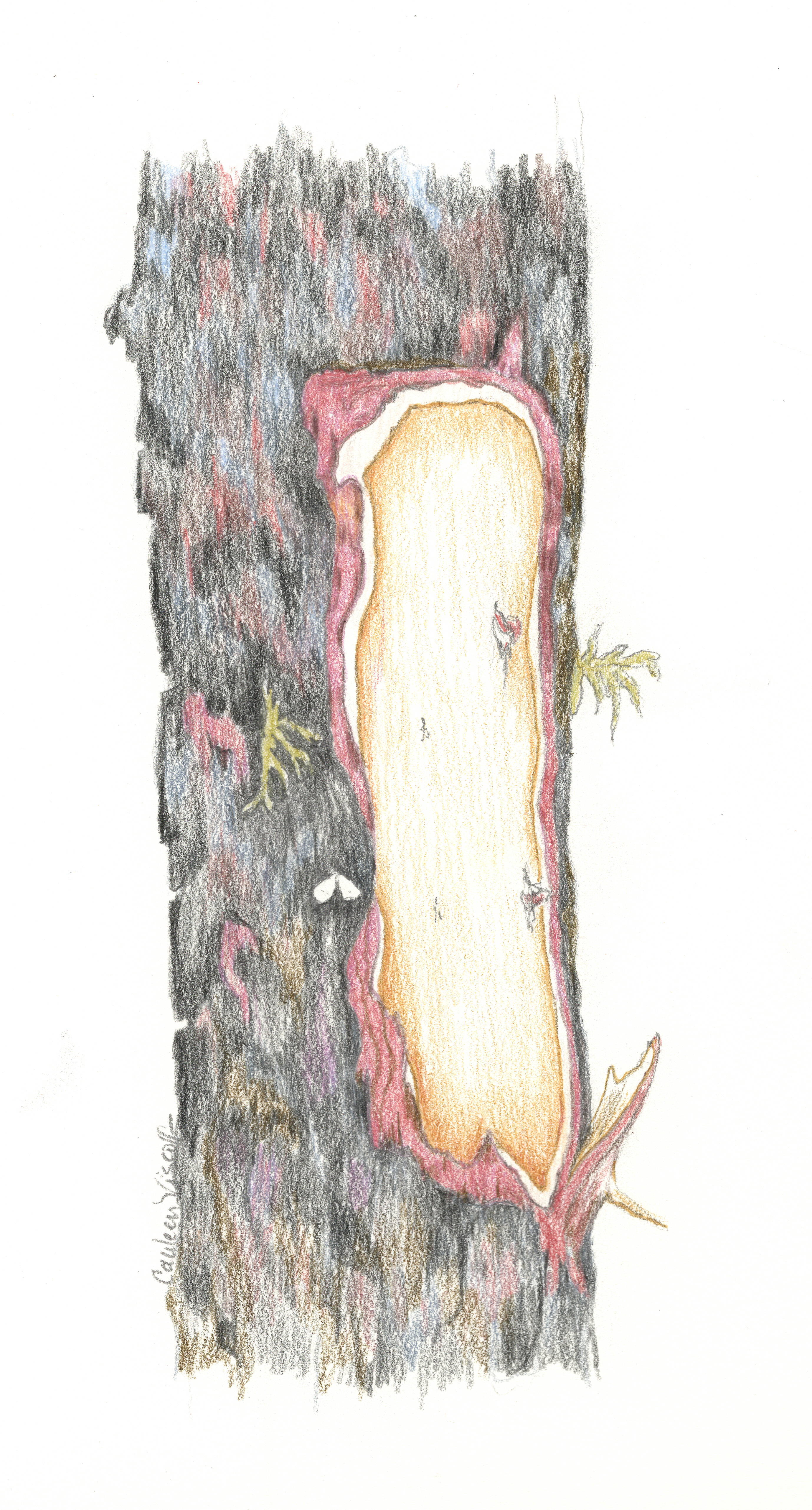
TORN-BARK CUT... exposing the Cambium layer... that pale, soft inner bark between the outer bark and inner hard wood... it is the living part of the trunk; a pathway for nutrients.
Expert arborists are often able to treat such damage but it is not always successful.
Tree Pruning is an art in many ways. But understanding why when and how it is done to maintain the health of each tree will go a long way in your own garden.
And, understanding our own limitations is necessary... we need the right tree, right tools and right knowledge in order to be successful.
And, knowing when to hire an expert.


